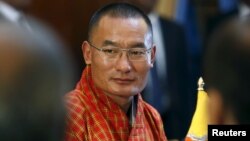People in Bhutan are happier now than they were five years ago according to a survey of social well-being released by the tiny Himalayan kingdom that, among other things, measures whether they are getting enough sleep.
Mostly Buddhist Bhutan, wedged between China and India, launched the Gross National Happiness (GNH) index in 2010 to include indicators ignored by conventional GDP - the monetary value of all goods and services produced in a country.
These range from quality-of-life indicators like leisure time and forest cover to whether people experience negative emotions like anger and envy.
Addressing a conference on GNH in the capital Thimphu on Tuesday, Prime Minister Lyonchoen Tshering Tobgay said the index inched up to 0.756 this year from 0.743 in 2010, but that he did not know yet what was a good growth rate.
The constitutional monarchy's goal is for every citizen to be "extensively or deeply happy," compared with the current figure of 43.4 percent.
"We saw some modest gains in areas such as living standards, health and time use," Tobgay said, according to a copy of his speech, adding that 7 percent more Bhutanese got enough sleep in 2015 than in 2010. "But in other areas such as community vitality and psychological wellbeing indicators, we actually seem to lose ground."
The gross national income of Bhutan - which until the 1960s was an isolated rural society with no currency, telephones, schools, hospitals or public services - has been consistently higher than that of South Asia as a whole, according to World Bank data from 2006 to 2014.
But Rajesh Kharat, who teaches South Asian studies at New Delhi's Jawaharlal Nehru University and advises the government of Bhutan, says GNH's benefits have been confined to towns where communication is better.
"GNH has become internationally popular but yet to reach a single person in the villages," Kharat said. "The main thing is education. Most of the people in rural areas have not really understood whether Bhutan is a monarchy or a democracy."
Tobgay too said he was troubled that the improvement in the GNH was strongest in towns instead of "our fields and valleys and hamlets high up in the mist", a worrying sign for the landlocked country.
More than half its 349,000 labor force still works in agriculture.
"We must find ways of energizing GNH in rural areas, so young people build their careers and families in our beautiful villages as mature modern men and women, and don't only yearn for the city lights," he said.







